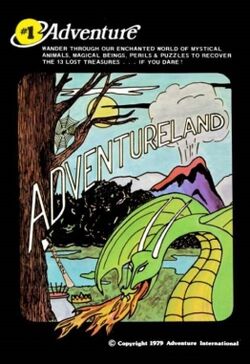Software:Adventureland (video game)
| Adventureland | |
|---|---|
 | |
| Publisher(s) | Creative Computing Software Adventure International |
| Designer(s) | Scott Adams |
| Series | Adventure |
| Platform(s) | TRS-80, Apple II, Atari 8-bit, TI-99/4A, PET, Commodore 64, IBM PC, VIC-20, ZX Spectrum, BBC Micro, Acorn Electron, Dragon 32/64, Exidy Sorcerer |
| Release | 1978 |
| Genre(s) | Interactive fiction |
Adventureland is a text adventure video game for microcomputers,[1] released by Scott Adams in 1978. The game has no plot[2] but simply involves searching for thirteen lost artifacts in a fantasy setting. Its success led Adams to form Adventure International,[3] which went on to publish thirteen similar games in the Adventure series, each in different settings.
Gameplay
Adventureland is controlled through the use of written commands. These can consist of a single word, such as those used for player character movement, including north, south, east, west, up, and down. They can also take the form of simple, two-word verb/noun phrases, such as "climb tree". Although the game can recognize about 120 words, the parser only takes the first three letters into account.[4][5] This means not only that the parser occasionally misidentifies words, but also that commands can be truncated: "lig lam" would be interpreted as "light lamp".
In order to complete the game, the player has to collect the thirteen lost artifacts: A statue of Paul Bunyan's blue ox, Babe, the jeweled fruit, the golden fish, a dragon's egg, a golden net, a magic carpet, a diamond necklace, a diamond bracelet, a pot of rubies, the "royal honey", a crown, a magic mirror, and a "firestone".[6]
Development
Adventureland, Adams' first program, was inspired by[7] the earlier Colossal Cave Adventure, though it is not on the same scale.Cite error: Closing </ref> missing for <ref> tag
In 1982, Adventureland was re-released with graphics, thus enabling the player to view visible representations of the scenery and objects.[8][9]
Reception
Mark Herro for Dragon commented that "I can't recommend ANY version of Scott Adams' Adventure series highly enough. Beg, borrow, or steal a chance to play Adventure!"[10] British print magazine Micro Adventurer praised the VIC-20 version was released as a cartridge as the loading times would be too long otherwise. The screen format and parser were "standard" according to the magazine. It criticized minor controlling features, the non-consistent map and the seemingly random placement of treasures.[11]
References
- ↑ Griffin, Brad (March–April 1983). "Scott Adams Adventures 1–12". ANALOG Computing (10). http://www.cyberroach.com/analog/an10/default.htm. Retrieved 13 April 2015.
- ↑ Adventure No. 01 - Adventureland v3.9-416 (1981)(Adventure International) https://archive.org/details/Adventure_No._01_Adventureland_v3.9-416_1981_Adventure_International
- ↑ "Game Set Interview: Adventure International's Scott Adams" , Game Set Watch, July 19th, 2006, retrieved on April 20, 2009
- ↑ Adventure No. 01 - Adventureland v3.9-416 (1981)(Adventure International) https://archive.org/details/Adventure_No._01_Adventureland_v3.9-416_1981_Adventure_International
- ↑ "Great Scott". GamesTM (88): pp. 152–157. 2009.
- ↑ Adventure No. 01 - Adventureland v3.9-416 (1981)(Adventure International) https://archive.org/details/Adventure_No._01_Adventureland_v3.9-416_1981_Adventure_International
- ↑ Dennis G. Jerz, Somewhere Nearby is Colossal Cave: Examining Will Crowther's Original “Adventure” in Code and in Kentucky, http://www.digitalhumanities.org/dhq/vol/001/2/000009/000009.html
- ↑ Virtually Real:being in cyberspace, M. Leigh, 2014, PHD thesis, https://figshare.utas.edu.au/articles/thesis/Virtually_real_being_in_cyberspace/23242163, p 22
- ↑ "Scott Adams Classic Adventures", Adventureland, retrieved April 20, 2009
- ↑ Cite error: Invalid
<ref>tag; no text was provided for refs namedDragon42 - ↑ "Thanks for the memory" (in en). Micro Adventurer: 19. 1983-11-01.
External links
- "Adventureland game walkthrough part 1 commodore 64 version." YouTube, 15 February 2013, accessed 31 October 2020
 |
